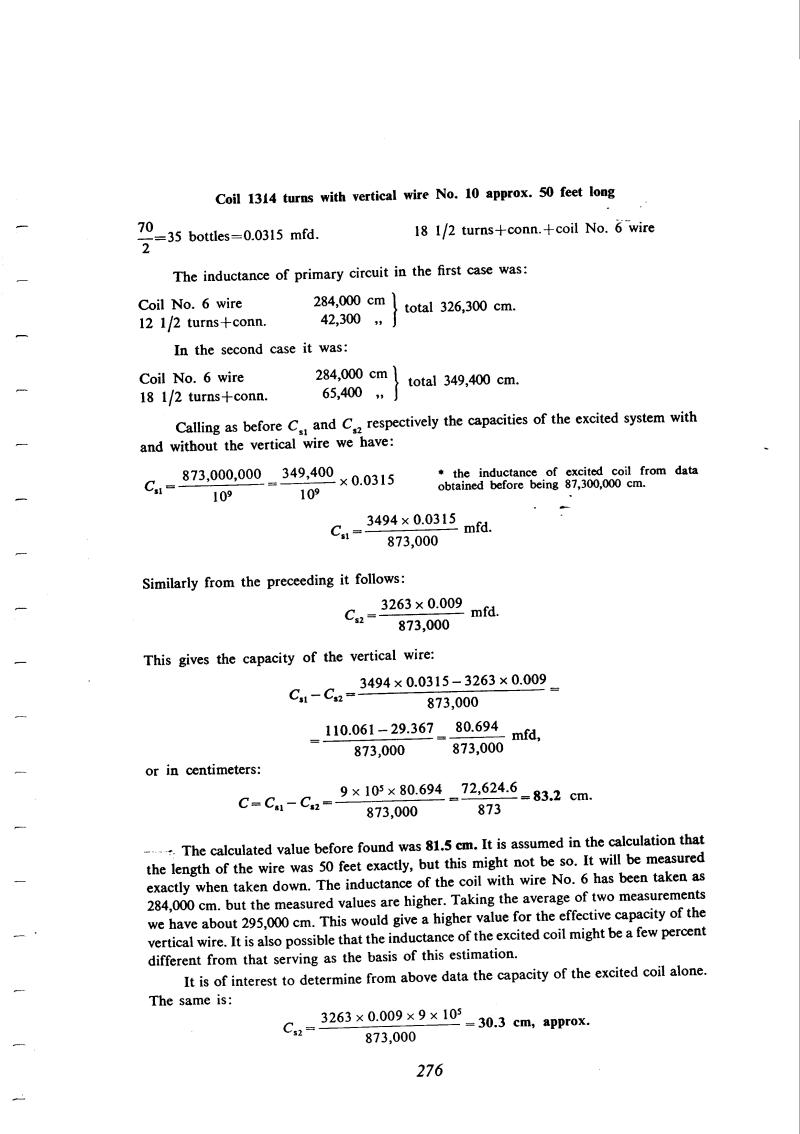
Nikola Tesla Books
Coil 1314 turns with vertical wire No. 10 approx. 50 feet long
| Capacity in primary circuit | Inductance in primary circuit |
|---|---|
| $! {70 \over 2} $! = 35 bottles = 0.0315 mfd. | 18 1/2 turns + conn. + coil No. 6 wire |
The inductance of primary circuit in the first case was:
| Coil No. 6 wire | 284,000 cm | } | total 326,300 cm. |
| 12 1/2 turns + conn. | 42,300 " |
In the second case it was:
| Coil No. 6 wire | 284,000 cm | } | total 349,400 cm. |
| 18 1/2 turns + conn. | 65,400 " |
Calling as before Cs1 and Cs2 respectively the capacities of the excited system with and without the vertical wire we have:
| Cs1 = $! {873,000,000 \over 10^{9}} $! = $! {349,400 \over 10^{9}} $! x 0.0315 | * the inductance of excited coil from data obtained before being 87,300,000 cm. |
Cs1 = $! {{3494 \times 0.0315} \over 873,000} $! mfd.
Similarly from the preceding it follows:
Cs2 = $! {{3263 \times 0.009} \over 873,000} $! mfd.
This gives the capacity of the vertical wire:
Cs1-Cs2 = $! {{3494 \times 0.0315 - 3263 \times 0.009} \over 873,000} $! =
= $! {{110.061 - 29.367} \over 873,000} $! = $! {80.694 \over 873,000} $! mfd,
or in centimeters:
C = Cs1 - Cs2 = $! {{9 \times 10^{5} \times 80.694} \over 873,000} $! = $! {72,624.6 \over 873} $! = 83.2 cm.
The calculated value before found was 81.5 cm. It is assumed in the calculation that the length of the wire was 50 feet exactly, but this might not be so. It will be measured exactly when taken down. The inductance of the coil with wire No. 6 has been taken as 284,000 cm. but the measured values are higher. Taking the average of two measurements we have about 295,000 cm. This would give a higher value for the effective capacity of the vertical wire. It is also possible that the inductance of the excited coil might be a few percent different from that serving as the basis of this estimation.
It is of interest to determine from above data the capacity of the excited coil alone. The same is:
Cs2 = $! {{3263 \times 0.009 \times 9 \times 10^{5}} \over 873,000} $! = 30.3 cm, approx.
276
November 10
Had Tesla published the measuring methods he developed in New York and Colorado Springs, his name would probably be frequently encountered in earlier textbooks and handbooks on electrical measurements at high frequencies. As it is, we can only remark his exceptional ingenuity in designing measuring devices and the accuracy with which he determined the resonance of oscillatory circuits. An especially interesting feature is his method using a lamp already heated up by a supplementary power source, greatly increasing its sensitivity to small amplitude changes around the resonance peak of the oscillatory circuit.
November 10
He winds a new coil with 1314 turns on the same core on which he wound 689 turns (please see Oct. 18) and later 346 turns (please see Oct. 31). With this coil he measures the metal sphere capacitance again and achieves a similar value as on November 7, with "additional coil". At the end of these measurements and calculations he establishes that the method of resonance determination on the basis of spark length in the arc gap is not quite satisfactory. In the following experiments he changes the resonance determination procedure. He returns to a method which he applied earlier in the New York laboratory. That method was based on the use of an auxiliary secondary coil, in a weak inductive link with excitation system, at which terminal is the instrument for the registration of current or voltage change in the secondary. usually for the registration of changes a small bulb was used. The variation of the method is particularly interesting where the small bulb is preheated by means of a D.C. current (please see Fig. 2). The preheated bulb could register very small excitation changes from the high frequency direct current circuit, which are applied to additionally heat up the already preheated filament in order to emit visual light.
By using the newly applied method of resonance indication he performs some measurements again and he measures the capacitance of a vertical wire 50 ft. in length. After this he switches over to determine the coil self-capacitance with 1314 turns. The measured result he compared with the calculated one for the capacitance of a metal cylinder of the same shape as the coil. According to Tesla, this serves only as a rough estimate. When they are using the entire coil length in the first calculation, he obtained a higher value than measured, he takes the effective coil length on the basis of bare wire. It is obvious that Tesla looks for orientation of the theoretical equations in order to be able to estimate parameters, but the experiment is the most effective factor. As far as the problem of determining the coil self capacitance, this is evident from the first days of the notes (please see eg. June 20, July 3, etc.)

